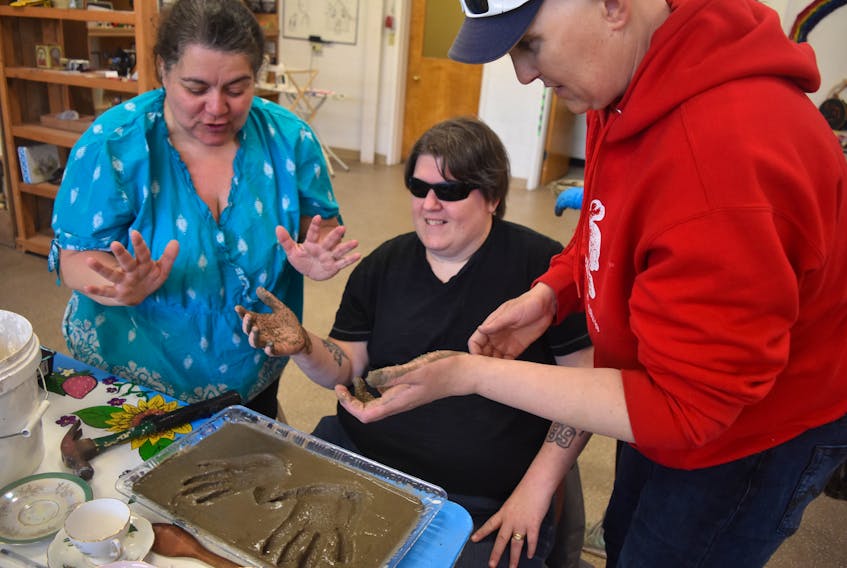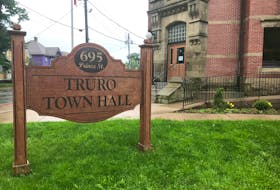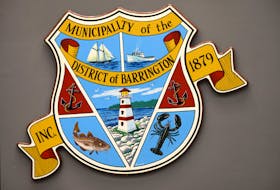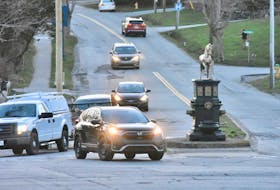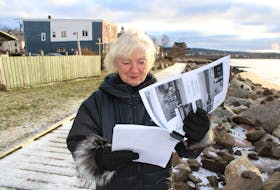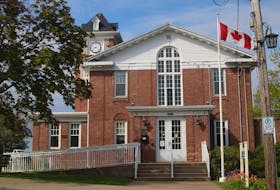Craig Aucoin describes his eye sight as a black and white TV with a thick fog in front of it.
“I can still see light in the sides of my eyes. And shadows. But in about three or four years that will be gone too,” said Aucoin over the phone on a rainy Thursday morning from his home in Pictou. It started when he was eight years old.
“My hands are my eyes now,” he said, “and I’m like a GPS in my memory.”
On Wednesdays Aucoin and his wife Terri-Lynn go to an were in an art studio in New Glasgow with 10 other people who all have some degree of vision loss.
Neither Craig or Terri-Lynn had given much thought to art classes before this one started nearly a month ago.
“I wasn’t sure what it was going to be like, but I’m so glad that I took the plunge,” said Terri-Lynn. The class takes place in the NSCAD studio behind the New Glasgow Library.

On Wednesday, the group were making garden stones. The artists took sea glass, shells, and pieces of broken tea-cups and placed them in wet cement before it could harden in the plastic molds in front of them.
Crashing above the table-side conversations was the sounds of the artists smashing glass inside big plastic buckets.
“We’re going to be doing some sculpture that is tactile and durable so people can touch it and experience it different way so that it’s not just visual,” NSCAD artist in residence Sarah Mosher. In conjunction with the New Glasgow town library Mosher runs a vision loss support art group.
On Wednesday, with a tray of wet cement in front of them, the Aucoins made imprints of their hands and Terri-Lynn ornamented the inside of the palm prints with hearts made from tea cup handles.
The project was left over night to harden, and will be ready when the group meets again next week.
“It was fun, it was so much fun,” said Terri-Lynn on Thursday.
Terri-Lynn was twenty-four years old when she lost her vision.
“It was overnight. I was on MSG messenger. It was just before Facebook came out. I have a friend in Australia and of course we’d have to stay up later to talk. I went to bed at midnight, woke up at 8:00 the next morning and poof my world was totally changed. I couldn’t see anything. Everything was a blur.”
Terri-Lynn could still see color, but could not make out the numbers written on the needle that she used to administer her insulin shot.
Many doctor visits later, and Terri-Lynn was diagnosed with diabetic retinopathy, and eight months after waking up in a blur she had lost all sight in her left and right eyes.
'There are two types of people in the world: Those who have a disability, and those who haven't found one yet'

There are 2,500 in Pictou County whose visual impairment cannot be treated with corrective lenses, and the Aucoins are among the ten percent of those with vision loss in the county whose blindness is total.
Julie Martin is an advocate for the visually impaired, and a chairperson on the Let Abilities Work Society. Martin and Mosher were brought together through the New Glasgow Town Library in order to make these art classes a reality, and she attends the classes regularly. Along with everyone in the group, from the participants to the assistants to their instructor all live with some degree of vision loss.
“There are two types of people in the world,” said Martin in a phone interview. “Those who have a disability, and those who haven’t found one yet.”
On Wednesday, she was wearing a T-shirt with the words ‘Keep Calm, it’s only a cane’ written on the front with a crosswalk figure holding a long cane.
“Whether it be because of cataracts, or they break a leg and are in a wheel chair for six weeks or a severe concussion that effects their memory, at some point in your life you’re going to face a disability and you’re going to realize, holy shit, it’s not that easy.”
Through wellness grants, Martin says that the New Glasgow library is able to supply people who have vision loss with the expensive adaptive equipment that they need to read. Those grants, which come through the local community health board have been instrumental in making the vision loss support art group a reality.
“I’m thrilled at the support we get in the community, especially the library, to make sure that we have safe and inclusive spaces to participate in these programs,” said Martin.
“A lot of times I feel that when people approach me or I approach people it’s like they treat me like I’m fragile, if that makes sense,” said Craig Aucoin. “Because I’m visually impaired they’re like ‘oh he can’t do this or he can’t do that'. It’s kind of like you’ve got a label on you.”
It seems then that Craig’s experience with vision loss has continually redefined that label.
“Twenty years ago, I was depressed. 240 pounds and going nowhere fast. But I started being friends with one guy who volunteered at the YMCA. After he left the Y he kept on volunteering with me, and one day he asked me if I ever thought about running.”
Craig assumed that his friend had meant for them to go running on a treadmill.
“But ‘no’, he said ‘outside’. Since that day I’m always open for anything. I’ll do anything.”
With a limited time left on the calendar, the art group is working to complete its main project: A 25-piece patch-work quilt with an eye designed in each square by a member of the group.
“It’s about what we see,” said Aucoin. “What it’s like from our eyes.”

